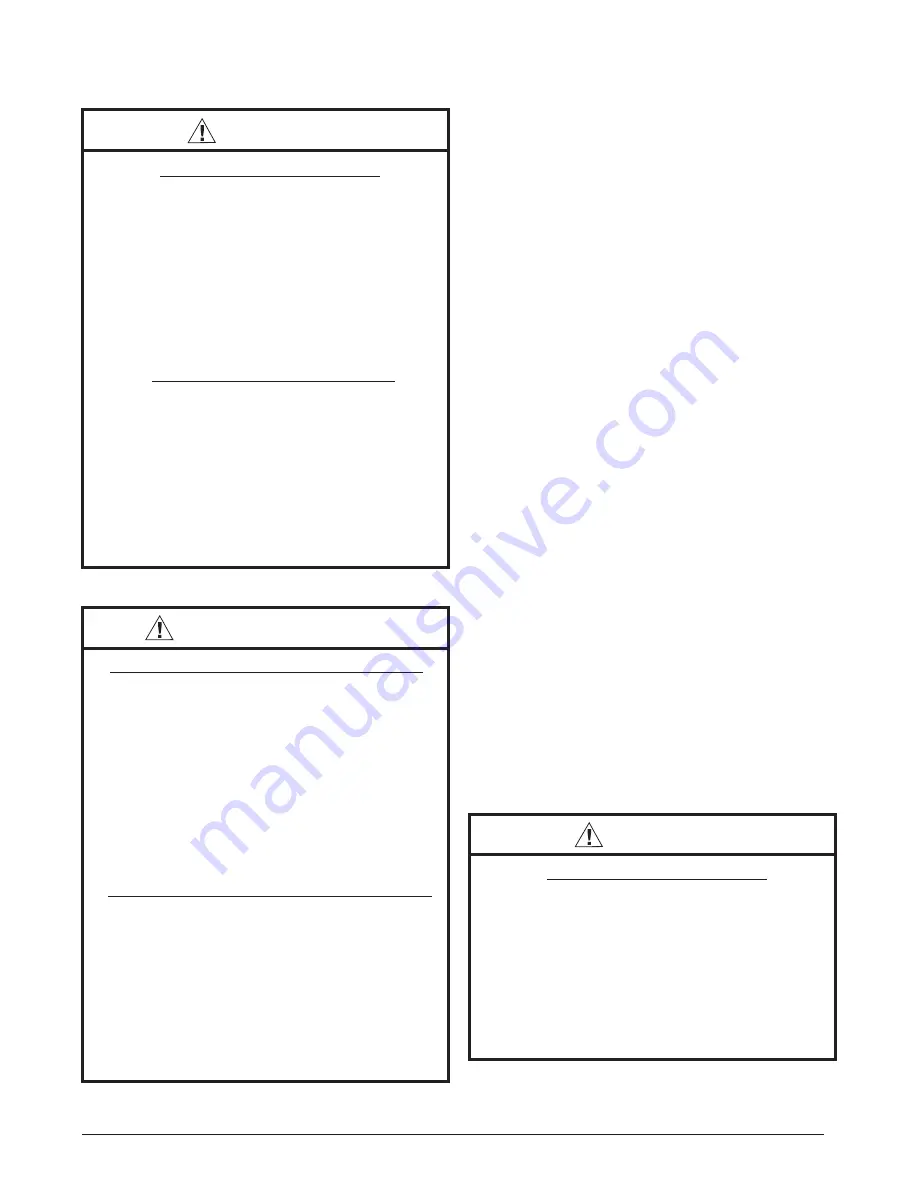
15
GAS SUPPLY & PIPING
FIRE OR EXPLOSION HAZARD
• Failure to follow safety warnings exactly
could result in serious injury or property
damage.
• Installation and service must be performed
by a qualifi ed installer, service agency or
the gas supplier.
• Do not store or use gasoline or other
fl ammable vapors and liquids in the
vicinity of this or any other appliance.
WHAT TO DO IF YOU SMELL GAS
• Do not try to light any appliance.
• Do not touch any electrical switch; do not
use any phone in your building.
• Leave the building immediately.
• Immediately call your gas supplier from
a neighbor’s phone. Follow the gas
supplier’s instructions.
• If you cannot reach your gas supplier, call
the fi re department.
WARNING:
RISQUE D’INCENDIE OU D’ EXPLOSION
• Le non-respect des avertissements de sécurité
pourrait entraîner des blessures graves, la mort
ou des dommages matériels.
• L’installation et l’entretien doivent être effectués
par un installateur qualifié, un organisme de
service ou le fournisseur de gazstaller, service
agency or the gas supplier.
• Ne pas entreposer ni utiliser de l’essence ni
d’autres vapeurs ou liquides infl ammables dans le
voisinage de cet appareil, ni de tout autre appareil.
QUE FAIRE S’IL Y A UNE ODEUR DE GAZ
• Ne pas tenter d’allumer aucun appareil.
• Ne toucher à aucun interrupteur électrique;
n’utiliser aucun téléphone dans le bâtiment.
• Évacuer l’immeuble immédiatement.
• Appeler immédiatement le fournisseur de gaz en
employant le téléphone d’un voisin. Respecter à
la lettre les instructions du fournisseur de gaz.
• Si personne ne répond, appeler le service des
incendies.
AVERTISSEMENT:
• All gas piping must be installed in compliance with
local codes and utility regulations. In the absence
of local codes the gas line installation must comply
with the latest edition of the National Fuel Gas Code
(ANSI Z223.1) or (CAN/CGA B149.1 or .2) Installation
Codes.
• Some local regulations require the installation of a
manual main shut-off valve and ground joint union
external to the furnace. The shut-off valve should
be readily accessible for service and/or emergency
use. Consult the local utility or gas supplier for
additional requirements regarding placement of the
manual main gas shut-off. See Figure 13 (page 17).
• Gas piping must never run in or through air ducts,
chimneys, gas vents, or elevator shafts.
• Compounds used to seal joints on gas piping must
be resistant to the actions of LP propane gas.
• The main gas valve and main power disconnect to
the furnace must be properly labeled by the installer
in case emergency shutdown is required.
• Flexible gas connectors are not recommended for
this type of furnace but may be used if allowed by
local jurisdiction. The fl exible gas connector must
be agency approved and certifi ed for the type of
gas being used. Only new fl exible connectors may
be used. Do not reuse old fl exible gas connectors.
• A drip leg should be installed in the vertical pipe
run to the unit. See Figure 13.
Table 9 (page 38) lists gas pipe capacities for standard
pipe sizes as a function of length in typical applications
based on nominal pressure drop in the line.
The furnace may be installed for either left or right side gas
entry. When connecting the gas supply, provide clearance
between the gas supply line and the entry hole in the
furnace casing to avoid unwanted noise and/or damage to
the furnace. Typical gas hookups are shown in Figure 13.
Leak Check
FIRE OR EXPLOSION HAZARD
Failure to follow safety warnings exactly could
result in serious injury or property damage.
Never test for gas leaks with an open fl ame.
Use a commercially available soap solution
made specifi cally for the detection of leaks
to check all connections. A fi re or explosion
may result causing property damage, personal
injury or loss of life.
WARNING:
















































